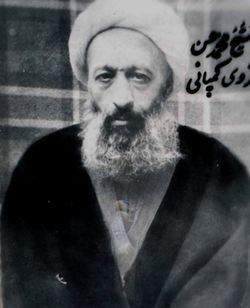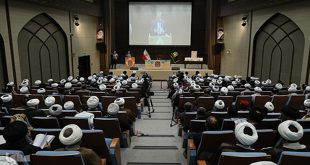Muḥammad Ḥosayn Gharawī Isfahānī (b.1296/1879 – d.1361/1942), known as Kumpānī, is a scholar of fiqh, usul (principles of fiqh) and a philosopher of 14th/20th century.
Along with Aqa Diya’ ‘Iraqi and Mirza Na’ini, he has established one of the three intellectual schools of usul as a development of al-Shaykh al-Ansari‘s school of usul, though his attempt to rearrange the discipline of usul remained unfinished because of his death. His is well-known as a deep and astute thinker. His Nihaya al-Diraya is one of the most important works in usul al-fiqh, which is written as a commentary on Akhund Khurasani‘s Kifaya. His Diwan (collection of poems) has also been published with the pen name, muftaqir (needy person), concerning the praise of Ahl al-Bayt (a).
Born
Muḥammad Ḥosayn Gharawī Isfahānī, son of Muhammad Hasan Isfahani Nakhjawani, was born in Najaf in the second day of Muharram in 1296/1879. His father was a famous businessman in Kadhimiya, but he was originally from Nakhchivan, Azerbaijan.
Migration
After the Treaty of Turkmenchay was signed, he first migrated to Tabriz and then to Isfahan, and then to Kazimayn. His father liked him to become a business man, but by appealing to Imam al-Kazim (a), he could convince his father to let him learn Islamic sciences. He went to Najaf when he was 20 years old. He also had a nice handwriting.
Because of his father’s career he came to be known as “Kumpani” (from the English word, “company”), but it has been said that he did not like to be called so. Yet his diwan of poems was published as the Diwan of kumpani.
Education
Isfahani studied the intermediate level with al-Shaykh Hasan Tuysirkani and some other teachers at Najaf. He attended the lectures of fiqh and usul by al-Sayyid Muhammad Fisharaki and Aqa Rida Hamadani. He also attended Akhund Khurasani‘s lectures for about 13 years. He was one of the best-known pupils of Akhund, and wrote his commentary on Akhund’s book, Kifaya, when he was still attending his lectures.
During this period, he just missed two lectures by Akhund; one was when he had gone to visit the Holy Shrine of Kazimayn (a) and could not go to the lecture because of a problem, and the other was when there was a heavy raining in Najaf and the streets of Najaf were almost closed, and he thought that Akhund would not go for the lecture. After Akhund died, he started teaching courses of usul and fiqh. His lectures were astute in an eloquent Arabic. The last course of his lectures in usul started in 1344/1926 and finished in 1359/1940, and it was his longest course of usul.
A New Arrangement of usul
After the last course of his lectures on usul, Isfahani started a new course in order to refine and rearrange the issues of usul. He made changes to the traditional arrangement of the issues of usul and brought some introductory issues back to their original place. He divided usul into four parts and tried to prevent confusions between the issues:
- Linguistic issues.
- Rational implications.
- Issues of evidence (hujja).
- Issues of practical principles (al-usul al-‘amaliyya).
He sought to publish a book on the basis of this new arrangement, but he died before that.
In addition to fiqh and usul, he also mastered kalam (Islamic theology), exegesis of the Qur’an, philosophy, history, literature and mysticism. He learned Islamic philosophy and theology from Mirza Muhammad Baqir Istahbanati. The influence of Islamic philosophy can be seen in his fiqh, usul, and even his poetry.
His Teachers
- Akhund Khurasani
- Al-Sayyid Muhammad Fisharaki
- Aqa Rida Hamadani
- Mirza Muhammad Baqir Istahbanati
- Al-Shaykh Hasan Tuysirkani
His Students
Many people attended Isfahani’s lectures, some of whom would become great religious authorities and teachers of Islamic seminaries. Some of his pupils include:
- Muhammad ‘Ali Araki (Isfahani’s son in law)
- Muhammad ‘Ali Urdubadi
- Nasr allah Ishkiwari
- ‘Allama Amini
- Anwari Hamadani
- Muhammad Taqi Bahjat Fumani
- Yusuf Biyari
- Al-Sayyid Sadr al-Din Jaza’iri
- Husayn Hamadani Najafi
- Al-Sayyid Hadi Khusrushahi
- Al-Sayyid ‘Ali Khalkhali
- Al-Sayyid Aqa Khalkhali
- Al-Sayyid Abu al-Qasim Khu’i
- Al-Sayyid Muhammad Ruhani
- Al-Sayyid Muhammad Husayn Tabataba’i
- Muhammad Taha
- al-Sayyid ‘Abbas Quchani
- Murtada Mudarrisi Chahardihi
- Muhammad Rida Muzaffar
- Al-Sayyid Hadi Milani
- Muhammad Tahir Najafi
- Al-Sayyid Husayn Hamadani
It has been said that upon his return from Mecca, Ayatollah Burujirdi stayed for four months in Najaf, and during this time, he attended Isfahani’s lectures.
Religious Authority (Marja’iyya)
After the demise of Mirza Na’ini, a statement was signed by Mirza ‘Ali Asghar Maliki who was a pupil of Akhund Khurasani, al-Sayyid Abu l-Qasim Khuy’i and al-Sayyid Muhammad Hadi Milani saying that after al-Shaykh al-Ansari, there has not been anyone like Ayatullah Isfahani in Shi’a clergies, and he is unique in the Islamic seminary of Najaf. In Baghdad, some people started following (taqlid) him.
His Works
- Nihaya al-diraya fi sharh al-kifaya ; this book is one of the most astute commentaries on Kifaya by Akhund Khurasani, and it is full of painstaking remarks and insights. The first part of the book was published in 1341/1923 and the second and the third parts were published in 1344/1926 in Tehran. The Institute of Al al-Bayt (a) has reprinted the book.
- Al-usul ‘ala al-nahj al-hadith (usul with a new method); this book was an attempt to reorganize and rearrange issues of usul which was left unfinished. Muhammad Rida Muzaffar wrote his book, usul al-fiqh, in accordance with this rearrangement.
- A commentary on al-Shaykh al-Ansari]]’s essay on certainty.
- Al-ijtihad wa al-taqlid wa al-‘adala ; this essay was published with two other works — Al-usul ‘ala al-nahj al-hadith, and Al-talab wa al-irada—in one volume under the title, Buhuth fi l-usul.
- Urjuza fi l-sawm (a brief on fasting)
- Al-Anwar al-qudsiyya ; 24 Arabic qasidas regarding the history of the Prophet (s) and some of his uncles and Imams (a) and some of their progeny. These qasidas refer to some verses of the Qur’an and some hadiths with a philosophical style; this work contains about 2000 poetic verses. The book has been published in Najaf with the introduction of al-Shaykh Muhammad ‘Ali Urdubadi.
- Tuhfa al-hakim ; it is a short poetry about philosophy in Arabic containing about 1000 verses. Mirza Mahdi Ashtiyani wrote a commentary on it up to the issue of mental existence (al-wujud al-dhihni) and Muhammad Baqir Sa’idi wrote a commentary on the whole work.
- A commentary on al-makasib ; it is a commentary on the fiqhi issues of bay’ (sales) and khiyarat (options for cancelling a transaction) in the book, Al-makasib by al-Shaykh al-Ansari.
- A commentary on Kitab al-tahara by al-Shaykh al-Ansari.
- Diwan (collection of poems) in Farsi. Isfahani’s penname is “muftaqir” (meaning a needy person). The work contains praises and lamentations of Ahl al-Bayt (a), and has repeatedly been published. In one of its publications it appears as Diwan-i Kumpani.
- Poems about i’tikaf.
In addition to these works, he has written several essays on fiqh and usul, such as those concerning renting (Ijara ), Collective prayer, Prayer of a traveler, Linguistic derivations, Receiving wages for religious obligations, The subject-matter of sciences, Equivocal words, Linguistic particles, use of words about correct objects or both correct and corrupted objects (Sahih wa a’am ), the rules of crossing (Tajawuz ), finishing (Faragh ), Asala al-sihha (principle of correctness), Asala al-yad (the principle of owning an object by having it at one’s disposal), Tahara (cleanness), The nature of right and judgment, a short statement of hari’a judgments in Farsi and Arabic called Al-Wasila, the Rule of la darar (no harm), Convention of words, Succedent condition, Signs of literal and figurative meanings, Shar’i literal meanings, Friday prayer.
According to a quote from al-Sayyid ‘Abbas Kashani, Isfahani has an unfinished exegesis of the Qur’an that has not been mentioned in his biographies.
His Morality
Isfahani had a sharp mind and was quick in response; his remarks, and even his lectures, were accompanied by humors. He spoke quietly, and this sometimes led to complaints on the part of his pupils. He was often engaged in worships. He has been said to have left his career for about 12 years to worship and to undergo mystical experiences, and such a mystical approach would be found in him throughout his life.
‘Allama Tabataba’i who was one of his pupils, writes that he was in connection with Mirza Jawad Aqa Maliki Tabrizi who was one of the greatest pupils of the late Akhund Mulla Husaynquli Hamadani, one of the best known shia mystics.
Muhammad Taqi Bahjat, another pupil of Isfahani, speaks of his enthusiasm for scholarly discussions and his persistence on reciting Ziyara ‘Ashura and Sura al-Qadr, and says: “he was such that if you considered his scholarly career, you would think that he has nothing else to do except studying and writing, and if you considered his worships and religious practices, you would think that he has nothing to do except worshiping. … Every Thursday, in accordance with the practice of the scholars of Najaf, he had a soaz (rawda) ceremony. There was a samovar in these ceremonies to serve tea for the visitors. Al-Shaykh Muhammad Husayn used to sit beside the samovar to serve tee on his own, and he ordered the shoes of the visitors.”
Demise
Muhammad Hosayn Gharawi Isfahani died in Dhu l-Hijja 5, 1361/1942 because of a heart attack. His corpse was buried in a chamber contiguous with the Northern Finial of the Golden Porch of the Holy Shrine of ‘Amir al-Mu’minin (a), near the grave of al-‘Allama al-Hilli. He died one week after the death of Aqa Dia’ ‘Iraqi.
 Ijtihad Network Being Wise and Faithful Muslim in the Contemporary World
Ijtihad Network Being Wise and Faithful Muslim in the Contemporary World

